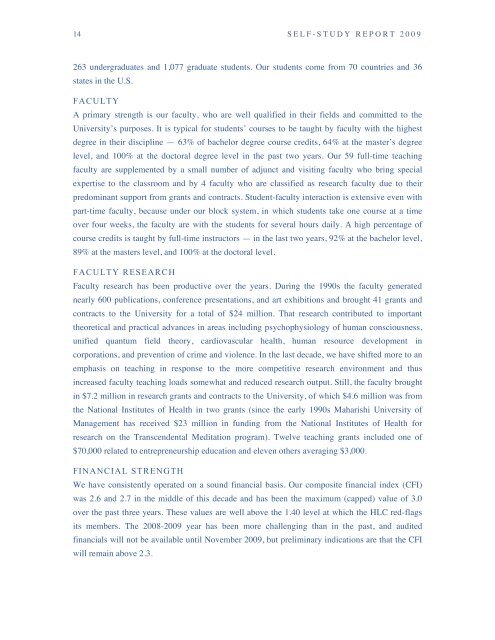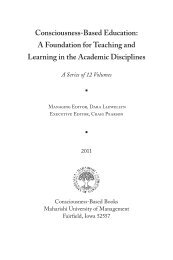Self Study - Maharishi University of Management
Self Study - Maharishi University of Management
Self Study - Maharishi University of Management
You also want an ePaper? Increase the reach of your titles
YUMPU automatically turns print PDFs into web optimized ePapers that Google loves.
14 S E L F - S T U D Y R E P O R T 2 0 0 9<br />
263 undergraduates and 1,077 graduate students. Our students come from 70 countries and 36<br />
states in the U.S.<br />
FACULTY<br />
A primary strength is our faculty, who are well qualified in their fields and committed to the<br />
<strong>University</strong>’s purposes. It is typical for students’ courses to be taught by faculty with the highest<br />
degree in their discipline — 63% <strong>of</strong> bachelor degree course credits, 64% at the master’s degree<br />
level, and 100% at the doctoral degree level in the past two years. Our 59 full-time teaching<br />
faculty are supplemented by a small number <strong>of</strong> adjunct and visiting faculty who bring special<br />
expertise to the classroom and by 4 faculty who are classified as research faculty due to their<br />
predominant support from grants and contracts. Student-faculty interaction is extensive even with<br />
part-time faculty, because under our block system, in which students take one course at a time<br />
over four weeks, the faculty are with the students for several hours daily. A high percentage <strong>of</strong><br />
course credits is taught by full-time instructors — in the last two years, 92% at the bachelor level,<br />
89% at the masters level, and 100% at the doctoral level.<br />
FACULTY RESEARCH<br />
Faculty research has been productive over the years. During the 1990s the faculty generated<br />
nearly 600 publications, conference presentations, and art exhibitions and brought 41 grants and<br />
contracts to the <strong>University</strong> for a total <strong>of</strong> $24 million. That research contributed to important<br />
theoretical and practical advances in areas including psychophysiology <strong>of</strong> human consciousness,<br />
unified quantum field theory, cardiovascular health, human resource development in<br />
corporations, and prevention <strong>of</strong> crime and violence. In the last decade, we have shifted more to an<br />
emphasis on teaching in response to the more competitive research environment and thus<br />
increased faculty teaching loads somewhat and reduced research output. Still, the faculty brought<br />
in $7.2 million in research grants and contracts to the <strong>University</strong>, <strong>of</strong> which $4.6 million was from<br />
the National Institutes <strong>of</strong> Health in two grants (since the early 1990s <strong>Maharishi</strong> <strong>University</strong> <strong>of</strong><br />
<strong>Management</strong> has received $23 million in funding from the National Institutes <strong>of</strong> Health for<br />
research on the Transcendental Meditation program). Twelve teaching grants included one <strong>of</strong><br />
$70,000 related to entrepreneurship education and eleven others averaging $3,000.<br />
FINANCIAL STRENGTH<br />
We have consistently operated on a sound financial basis. Our composite financial index (CFI)<br />
was 2.6 and 2.7 in the middle <strong>of</strong> this decade and has been the maximum (capped) value <strong>of</strong> 3.0<br />
over the past three years. These values are well above the 1.40 level at which the HLC red-flags<br />
its members. The 2008-2009 year has been more challenging than in the past, and audited<br />
financials will not be available until November 2009, but preliminary indications are that the CFI<br />
will remain above 2.3.

















